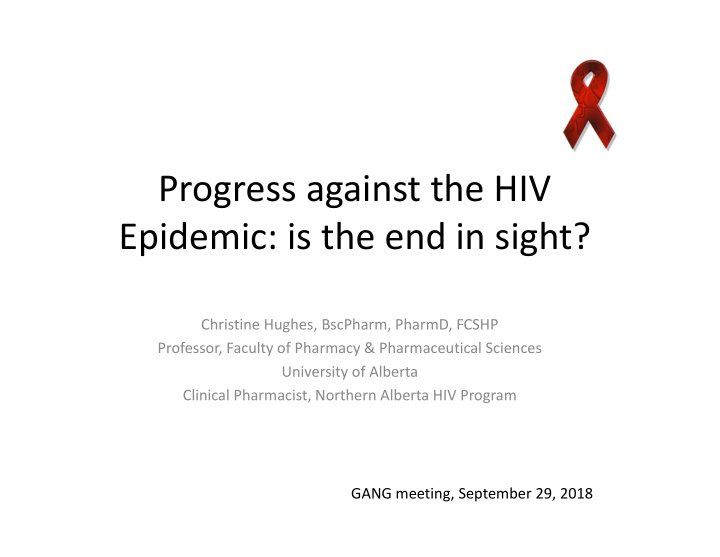



Progress against the HIV Epidemic: is the end in sight? Christine Hughes, BscPharm, PharmD, FCSHP Professor, Faculty of Pharmacy & Pharmaceutical Sciences University of Alberta Clinical Pharmacist, Northern Alberta HIV Program GANG meeting, September 29, 2018
Outline • What is HIV? • Global impact of HIV • Treatment of HIV in 2018 (in Africa and around the world) • UNAIDS goals and progress • Ongoing challenges to end the epidemic
What is HIV? • HIV = human immunodeficiency virus • Virus recognized in early 1980’s • Targets and destroys CD4 (helper) immune cells • End result: immune suppression – can lead to infections or infection ‐ related cancers
How is HIV transmitted?
GLOBAL IMPACT OF HIV
Adults and children estimated to be living with HIV 2016 Eastern Europe Eastern Europe and central Asia and central Asia North America and western and central North America and western and central 1.6 million 1.6 million Europe Europe [1.4 million–1.7 million] [1.4 million–1.7 million] 2.1 million 2.1 million [2.0 million–2.3 million] [2.0 million–2.3 million] Caribbean Caribbean Middle East and North Middle East and North Africa Africa 310 000 310 000 230 000 230 000 [280 000–350 000] [280 000–350 000] [160 000–380 000] [160 000–380 000] Western and central Western and central Asia and the Pacific Asia and the Pacific Africa Africa 6.1 million 6.1 million 5.1 million 5.1 million Latin America Latin America [4.9 million–7.6 million] [4.9 million–7.6 million] [3.9 million–7.2 million] [3.9 million–7.2 million] 1.8 million 1.8 million Eastern and southern Eastern and southern [1.4 million–2.1 million] [1.4 million–2.1 million] Africa Africa 19.4 million 19.4 million [17.8 million–21.1 million] [17.8 million–21.1 million] Total: 36.7 million [30.8 million–42.9 million] www.unaids.org
Global summary of the AIDS epidemic 2016 Total 36.7 million [30.8 million–42.9 million] Number of people Adults 34.5 million [28.8 million–40.2 million] living with HIV Women (15+ years) 17.8 million [15.4 million–20.3 million] Children (<15 years) 2.1 million [1.7 million–2.6 million] Total 1.8 million [1.6 million–2.1 million] People newly Adults 1.7 million [1.4 million–1.9 million] infected Children (<15 years) 160 000 [100 000–220 000] with HIV in 2016 Total 1.0 million [830 000–1.2 million] AIDS-related Adults 890 000 [740 000–1.1 million] deaths in 2016 Children (<15 years) 120 000 [79 000–160 000]
Populations most impacted by HIV differ considerably around the world and even in different regions within a country (e.g. Canada)
Newsweek December 2, 1996
Mid ‐ 1990’s: 3 ‐ Drug Combination ART introduced Zidovudine/Lamivudine/Indinavir 8AM 4PM 12 MID Fasting (1 hour before/2 hours after meals)1.5 liters of hydration/day
HIV TREATMENT TODAY
HIV TREATMENT in 2018 • > 25 licensed antiretroviral (ARV) drugs – used in combinations of at least 3 agents – regimens are simpler and well tolerated • No cure for HIV and no vaccine – Goal: suppress virus replication – life ‐ expectancy of people with HIV approaching ‘near normal’
TARGETS TO END HIV/AIDS AS A PUBLIC HEALTH THREAT BY 2030
Prevention is Key • People at risk of HIV infection have access to comprehensive HIV prevention services • Condoms, pre ‐ exposure HIV prophylaxis, clean needles/syringes etc
Not just medical interventions • Remove policy barriers to access prevention services • Eliminate gender inequalities and end all forms of violence and discrimination against women and girls, people living with HIV and key populations
Reducing stigma • Undetectable = Untransmittable • People who take antiretroviral therapy daily as prescribed and achieve and maintain an undetectable viral load have effectively no risk of sexually transmitting the virus to an HIV ‐ negative partner. (Reference: CDC)
PROGRESS IN REACHING UNAIDS TARGETS: ARE WE THERE YET?
Percent change in new HIV infections since 2010 ‐ 18 %
Ongoing Challenges…the road ahead • Shortfalls in HIV Funding – Contributing to inability to achieve UNAIDS goals – Focus on treatment impacts funding for other prevention efforts
Ongoing Challenges…the road ahead • Prevention of HIV transmission – concentration of the epidemic in marginalized populations – little progress in reducing number of new infections (including in Canada) – strong relationship to social determinants of health, stigma etc
Ongoing Challenges…the road ahead • Earlier identification of HIV infection – WHO has recommended since 2015 that people with HIV start antiretroviral therapy as soon as possible • Improves individual health and reduces transmission
Ongoing Challenges…the road ahead • Ability to achieve treatment success – Goal is undetectable viral load ‐ requires high level of treatment adherence – Addictions, mental health, stigma, poverty, access to care and treatment impact ability to achieve treatment success
“We live in a completely interdependent world, which simply means we can not escape each other. How we respond to AIDS depends, in part, on whether we understand this interdependence. It is not someone else's problem. This is everybody's problem.” ― Bill Clinton
THANK YOU FOR THE IMPORTANT WORK THAT YOU DO!
Recommend
More recommend